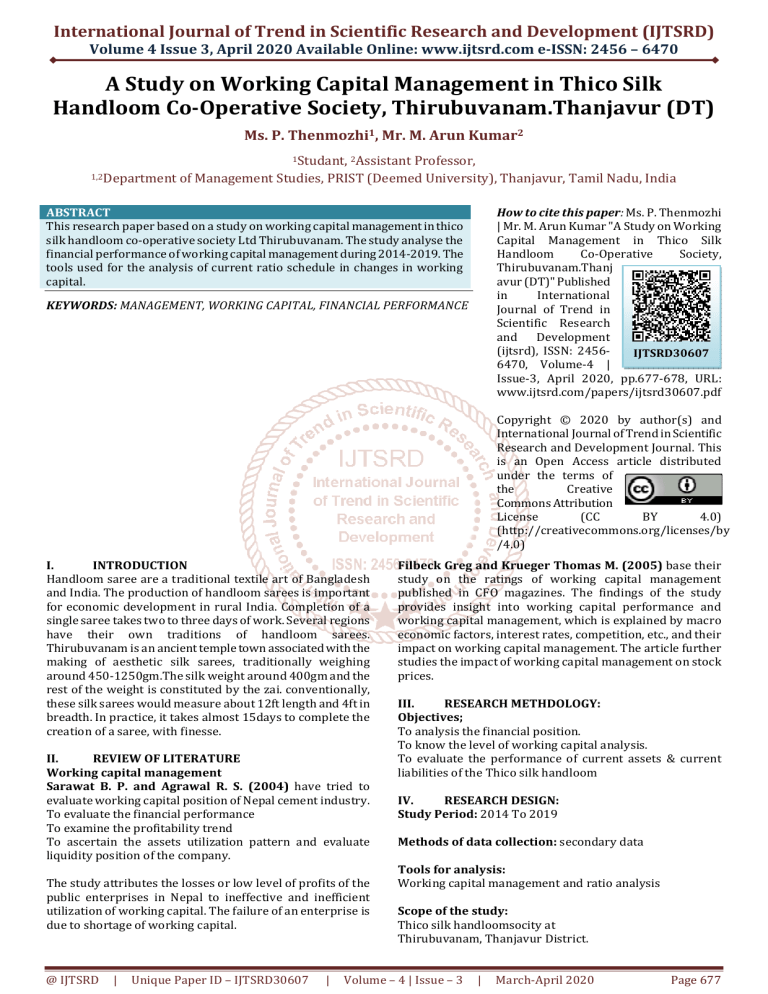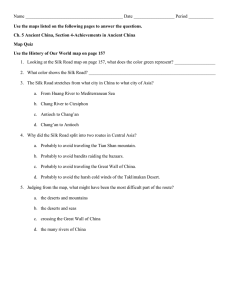
International Journal of Trend in Scientific Research and Development (IJTSRD)
Volume 4 Issue 3, April 2020 Available Online: www.ijtsrd.com e-ISSN: 2456 – 6470
A Study on Working Capital Management in Thico Silk
Handloom Co-Operative Society, Thirubuvanam.Thanjavur (DT)
Ms. P. Thenmozhi1, Mr. M. Arun Kumar2
1Studant, 2Assistant
Professor,
1,2Department of Management Studies, PRIST (Deemed University), Thanjavur, Tamil Nadu, India
How to cite this paper: Ms. P. Thenmozhi
| Mr. M. Arun Kumar "A Study on Working
Capital Management in Thico Silk
Handloom
Co-Operative
Society,
Thirubuvanam.Thanj
avur (DT)" Published
in
International
Journal of Trend in
Scientific Research
and Development
(ijtsrd), ISSN: 2456IJTSRD30607
6470, Volume-4 |
Issue-3, April 2020, pp.677-678, URL:
www.ijtsrd.com/papers/ijtsrd30607.pdf
ABSTRACT
This research paper based on a study on working capital management in thico
silk handloom co-operative society Ltd Thirubuvanam. The study analyse the
financial performance of working capital management during 2014-2019. The
tools used for the analysis of current ratio schedule in changes in working
capital.
KEYWORDS: MANAGEMENT, WORKING CAPITAL, FINANCIAL PERFORMANCE
Copyright © 2020 by author(s) and
International Journal of Trend in Scientific
Research and Development Journal. This
is an Open Access article distributed
under the terms of
the
Creative
Commons Attribution
License
(CC
BY
4.0)
(http://creativecommons.org/licenses/by
/4.0)
I.
INTRODUCTION
Handloom saree are a traditional textile art of Bangladesh
and India. The production of handloom sarees is important
for economic development in rural India. Completion of a
single saree takes two to three days of work. Several regions
have their own traditions of handloom sarees.
Thirubuvanam is an ancient temple town associated with the
making of aesthetic silk sarees, traditionally weighing
around 450-1250gm.The silk weight around 400gm and the
rest of the weight is constituted by the zai. conventionally,
these silk sarees would measure about 12ft length and 4ft in
breadth. In practice, it takes almost 15days to complete the
creation of a saree, with finesse.
II.
REVIEW OF LITERATURE
Working capital management
Sarawat B. P. and Agrawal R. S. (2004) have tried to
evaluate working capital position of Nepal cement industry.
To evaluate the financial performance
To examine the profitability trend
To ascertain the assets utilization pattern and evaluate
liquidity position of the company.
The study attributes the losses or low level of profits of the
public enterprises in Nepal to ineffective and inefficient
utilization of working capital. The failure of an enterprise is
due to shortage of working capital.
@ IJTSRD
|
Unique Paper ID – IJTSRD30607
|
Filbeck Greg and Krueger Thomas M. (2005) base their
study on the ratings of working capital management
published in CFO magazines. The findings of the study
provides insight into working capital performance and
working capital management, which is explained by macro
economic factors, interest rates, competition, etc., and their
impact on working capital management. The article further
studies the impact of working capital management on stock
prices.
III.
RESEARCH METHDOLOGY:
Objectives;
To analysis the financial position.
To know the level of working capital analysis.
To evaluate the performance of current assets & current
liabilities of the Thico silk handloom
IV.
RESEARCH DESIGN:
Study Period: 2014 To 2019
Methods of data collection: secondary data
Tools for analysis:
Working capital management and ratio analysis
Scope of the study:
Thico silk handloomsocity at
Thirubuvanam, Thanjavur District.
Volume – 4 | Issue – 3
|
March-April 2020
Page 677
International Journal of Trend in Scientific Research and Development (IJTSRD) @ www.ijtsrd.com eISSN: 2456-6470
Limitation of study:
This study is mainly based on secondary data like
annual report
A details analysis is not possible as the time is short
V.
PRODUCTION AND SALE SOCIETY LTD. NO. Z.322. with
almost satisfactions would like to thank all the member and
staff who accessed me in collecting information regarding
the silk sarees. They helped me in all the way by giving detail
about each and every department.
Data analysis:
Statement of changes in working capital
Increase\
Year
Net working capital
(Decrease)
2014-2015
124882300
68,785,729
2015-2016
626531116
69,593,677
2016-2017
86063341
30,260,630
2017-2018
34676127
18,657,726
2018-2019
35154173
1,100,846,931
The impact training under gone at THIRUBUVANAM silk
handloom weaver’s co-operative production and sale society
ltd.No.Z.322. Gave clear idea and practical knowledge about
marketing, purchase, finance, production, human resource
department activities carried out in this co-operative society.
This training was very useful to me and I have learned many
things in this implant training. It helps me to improve my
knowledge.
Interpretation
From the above table it is inferred that the net working
capital was increasing from the year 2014-2019 and
decreasing in the year 2016-2018.
REFERENCE
[1] Howorth, Carole, and Westhead, Paul, (2003), the
Focus of Working Capital Management in UK Small
Firms, Management Accounting Research, Vol.14, pp.
94-111
Year
2015
2016
2017
2018
2019
Ratio analysis
Current ratio
Gross profit
(Times)
ratio (Times)
1.29
0.09
1.13
0.09
1.17
0.09
1.07
0.08
1.07
0.08
Net profit
Ratio (Times)
0.07
0.08
0.07
0.07
0.07
Interpretation
From the above table infrared current ratio and gross profit
ratio and Net profit ratio and is highest in the year 2015.
2018-2019 little improvement of the company.
VI.
CONCLUSION:
I conclude this report on my practical implant training at
THIRUBUVANAM SILK HANDLOOM WEAVERS CO-OPERIVE
@ IJTSRD
|
Unique Paper ID – IJTSRD30607
|
[2] Sarawat, B. P., and Agrawal R. S., (2004), “Working
Capital Trends of Cement Industry in Nepal.” Indian
Journal of Accounting, Vol. XXXV, No. 1, pp. 26-35
[3] Filbeck Greg and Krueger Thomas M., (2005), An
Analysis of Working Management Results Across
Industries, American Journal of Business Finance, Vol.
20, No. 2, pp. 5-11
[4] Meszek, Wieslaw, and Polewski, Marcin, (2006),
Certain Aspects of Working Capital in a Construction
Company, Technological and Economic Development of
Economy, Vol. 12, No.3, pp. 222-226
[5] Ganesan Vedavinayagam, (2007), An Analysis of
Working Capital Management Efficiency in
Telecommunication Equipment Industry, Rivier
Academic Journal, Vol. 3, No. 2, pp. 1-10.
Volume – 4 | Issue – 3
|
March-April 2020
Page 678




